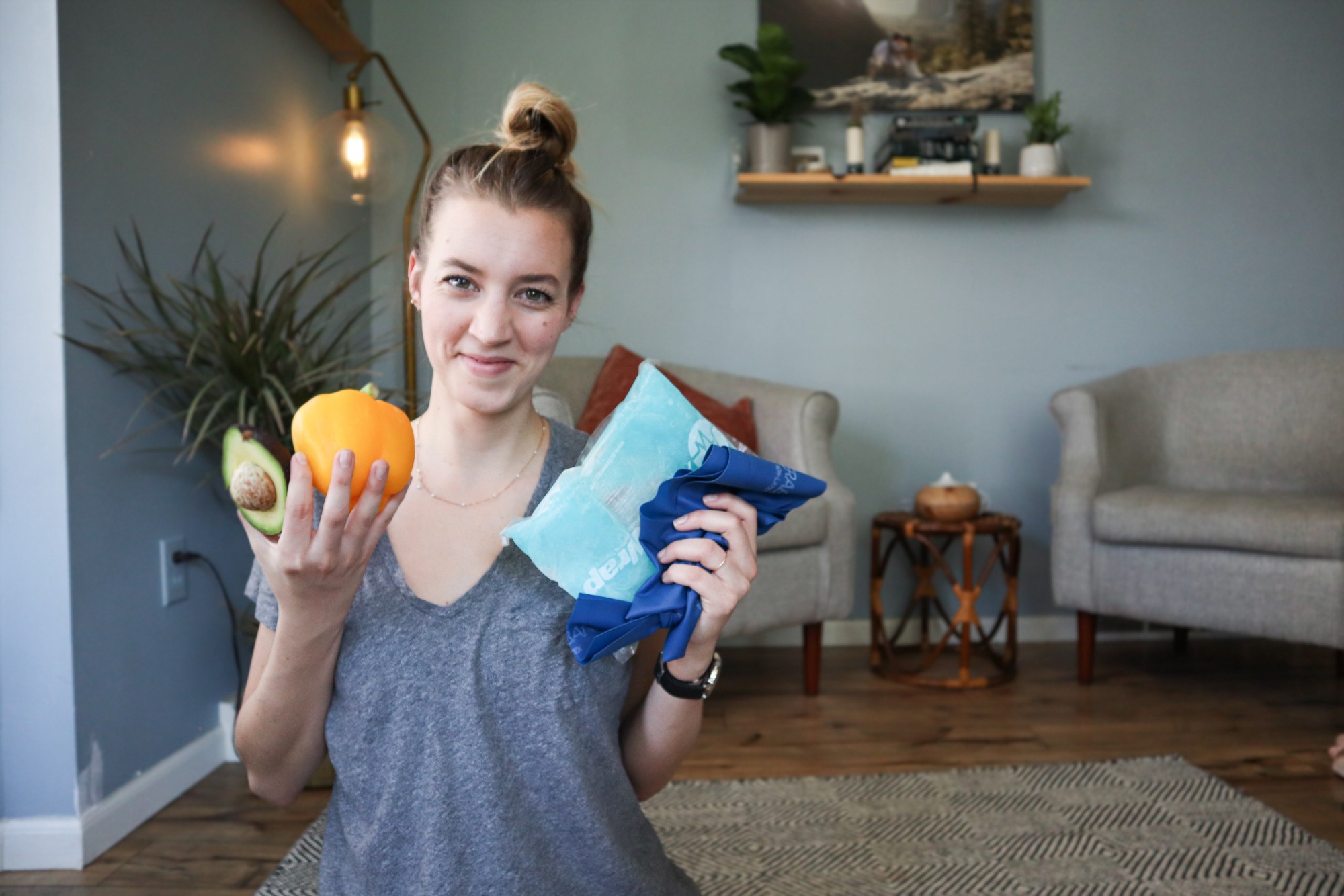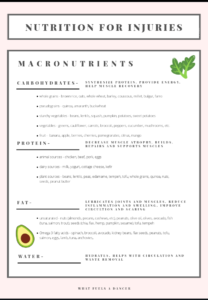Nutrition always plays an important role in a dancer’s overall health. During an injury though, it is even more crucial to receive proper nutrition for dancer recovery. Successful injury recovery focuses on a dancer’s physical, mental and emotional health so that they can return to the studio with a strong mind and body.
Why community is important in recovery
When it comes to an injury, every dancer’s path to recovery is going to look different. This also includes their nutrition. For dancers, injuries can be devastating, which is why it is important for you to have a supportive community during your recovery. Physical therapists, nutritionists, counselors, families, and friend groups can all aid in healing. For me personally, I started What Fuels a Dancer to be a resource to dancers and provide nutrition advice to help dancers improve their relationship with food and with their body while pursuing adequate nutrition.
I know not every dancer might have access to a nutrition professional who has personal experience dancing professionally, which is why I am so passionate about helping other dancers. Today, we are going to talk about three guidelines and specific recommendations for nutrition for dancer recovery.
Focus on fueling your body, not depriving it
When dancers are injured, many crave to have structure and control during the recovery process. Often, this turns into dieting, restricting calories or becoming obsessive over food. Many dancers are praised for coming back “skinnier”, but this can lead to unhealthy food behaviors that can be detrimental to injury recovery and your future health.
Instead, focus on tuning into your hunger cues and food cravings, no limiting foods, food groups or cutting calories. During the recovery process, you want to work with your body to gain your strength back. This means that you need to be fueling your body with the appropriate macronutrient and micronutrient intake so that you can come back to the studio physically and mentally ready to train.
Try new things when it comes to food
When we are dancing, it is easy to get into the habit of settling into certain meals and foods that we know work for our body. Instead this is a great time to experiment with different foods, and trying new meals and snacks to see what your body loves.
For me, I have always loved oatmeal as my breakfast before dance. I can change it up every day to be warm or cold and have different toppings to satisfy my taste buds. Recently, I have been trying out more savory breakfasts with veggies, potatoes, tempeh, tofu, avocado and toast. As it turns out, sometimes my body really loves having a savory meal in the morning, and it keeps me fueled and energized all morning.
Work on your relationship with food and your body
If you are experiencing an injury or unexpected time off, it is normal to become critical about the physical appearance of your body. Instead, shift your focus to change your views on what you think your body should look like as a dancer and focus more on how your body feels and functions.
We all know that ballet has some unrealistic and unhealthy body standards. Many dancers feel the need to undergo drastic measures to mold our bodies to this aesthetic. We can be so caught up in what we see in the mirror, that we forget to truly enjoy dancing. Having time away from the studio is a great opportunity to focus on repairing your relationship with food and with your body. We have a break from being in a leotard and tights in front of a mirror for eight hours each day, which gives us the space to change our thought patterns and behaviors surrounding our body.
This is not easy by any means, so having friends, family, and professionals who support you and provide encouragement and healthy feedback can help you during this change. It can even be helpful to change who you follow on social media. Follow dancers of all shapes and sizes as well as accounts that promote a positive body image and a non restrictive way of eating.
Nutrition basics
So, let’s talk about specific nutrition for dancer recovery.
Make sure you are balancing all three macronutrients: carbohydrates, protein, and fat. I have more in depth posts about each one of them here. So if you want to learn more, be sure to check those out. I also have a download that I created to make nutrition easier for dancer recovery! You can find that resource here!
Specifically when it comes to injury recovery, protein helps to combat muscle deterioration, also called muscle atrophy. You will lose some muscle when you are injured, but we want our nutrition to support and keep building those muscles as much as possible. Protein can also help repair injured muscles and prepare them for growth for when you are able to go back to normal activity.
Carbohydrates, especially complex carbohydrates, are important for muscle energy as well as it helps your body process protein. Carbohydrates all help with muscle recovery.
Fat, especially unsaturated and omega 3 fatty acids, lubricate our joints and muscles. They are also great to reduce inflammation and swelling and improve circulation and scaring.
Lastly, water is always important for hydration. During an injury, it especially helps with circulation and waste removal to aid in injury recovery.
Micronutrients for recovery
Once you have macronutrients down, there are some vitamins and minerals that are especially important during the recovery process. Vitamin C helps keep your skin, bones, and soft tissue in good condition. We can find this in foods like cherries, yellow peppers, parsley, spinach, kale, kiwi, broccoli, oranges and strawberries.
Calcium helps to repair bones, like in a fracture, and makes sure that your bones stay strong. Calcium is in foods like yogurt, milk, chia seeds, beans and lentils, almonds, greens and tofu.
Vitamin D helps to support and absorb calcium. It also supports your immune system and helps to reduce inflammation levels. We can get vitamin D from the sun, always making sure to follow safe sun practices, but we can also find it in foods like fortified milk, salmon, tuna, eggs, mushrooms, oats, and other fortified foods.
Iron helps your body produce red blood cells and collagen, which aids in bone regeneration. Iron is in foods like spinach, beans and legumes, red meat, pumpkin seeds, quinoa, broccoli, tofu and fish.
Magnesium helps preserve a healthy nerve and muscle function as well as it helps in bone production. There are several foods we can find magnesium in like avocado, dark chocolate, nuts, legumes, tofu, seeds and whole grains.
Omega 3 fatty acids help with inflammation levels to reduce swelling, improve circulation, and help prevent scar tissue build up. Omega 3 fatty acids can be found in foods like salmon and other seafood, flax seeds, chia seeds, walnuts and soybeans.
Potassium regulates muscle contractions and helps with proper nerve function. We can find it in foods like potatoes, sweet potatoes, beets, spinach, orange juice, bananas, avocado, salmon and coconut water.
Lastly, antioxidants help our bodies speed up the healing process, help prevent cellular damage, and may also help with inflammation levels. We can find antioxidants in a variety of fruits, vegetables, and other whole foods. Just like with any macronutrient, it is important to diversify our intake of food so that we can make sure we are getting all of the nutrition that we need.
Make sure to download the nutrition for injuries page to keep handy and help guide meals and snacks during your recovery process. There is not a magic food or meal plan that will make your body heal quickly and with total ease. Your recovery will also look different from other dancers. All of these are okay! Your injury recovery should be about strengthening your body, mind, and spirit so that you are ready to enter back into the studio healthy and refreshed. If you have any questions, please do not hesitate to reach out to me here!


